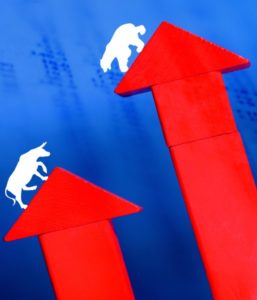The benefits of doing nothing in a Stock Market Sell-Off

Sound crazy? Let’s see. When Lehman Brothers went under in September 2008, it triggered a meltdown in the investment markets. Many investors sold some or all of their investments by the time the stock market hit bottom on March 9, 2009. The indices fell, crept up a bit, and then fell even further again several times until hitting bottom. What a nail biter.
Would it have been better to “do nothing” – that is, stay the course and remain in the market during market upheaval?
Let’s compare two strategies in the worst time of the Great Recession: Let’s look at a comparison of stock returns on a $1 million investment in the S & P 500 Index for two different strategies from the period of July 15. 2008 to December 15, 2009, 18 months:
a) “Do nothing” strategy. This strategy invests $1 million on July 15, 2008 in the S & P 500 Index, and holds it until December 15, 2009.
b) “Sell and reinvest later” strategy. This strategy invests $1 million on July 15, 2008, sells 100% on December 15, 2008, reinvests 100% on July 15, 2009, and holds until December 15, 2009.
- The “Do nothing” strategy reported a loss of -8.80%; in dollars is $(88,070). Ouch!
- The “Sell and re-invest later” strategy results are:
- Realized loss on December 15, 2008 of -28.51 %:
- The appreciated gain on the reinvestment on July 15, 2009 to December 15, 2009 was +18.79%
- The total loss on the “Sell and reinvest later” strategy was -9.72% or (-28.51% + 18.79%); in dollars was $(97,200), Yikes!!
The buy and hold investor earned an extra $9,130 ($97,200 – $88,070), or put another way, sustained a lower loss by $9,130. In this example, the “Do nothing” strategy prevailed in the most unnerving, chaotic stock market in modern history.
Another example of the benefits of staying the course in volatile markets is noted in an article written by Larry Swedroe, Director of Research for the BAM Alliance published October 18, 2017 for ETF.COM, Better To Face Correction. Mr. Swedroe makes a compelling case for staying invested during times of great volatility. From 1927 to 2016, the average monthly return for the S & P 500 Index was 0.95% which is close to 12% per year.
There were 1,092 months in that time frame. If the best performing 91 months were removed (They returned 8.5% per month in 91 months!), what would be the average return for the remaining 1,001 months? The returns were close to zero… 0.1%.
As he points out, many investors don’t know that most stock returns come in very short and unpredictable bursts.
Even though it is stressful and unnerving when stocks appear to be in a free fall as happened most recently in the fourth quarter of 2018, it is best to have a well thought-out, flexible, globally diversified plan that stands the test of time. Investment plans based on academic research are better equipped to ride out the market downturns and achieve optimal returns in rising stock markets.
During the Great Recession investors who held well-balanced stock and safe, fixed income investments did much better than most and protected their wealth during that time.
How? The investments that increased in value in the depth of the great recession were the safe, fixed income investments; these investments such as treasury bonds and bank CD’S achieved significant growth during that time.
As the Federal Reserve dropped rates and conducted Quantitative Easing (the purchase of fixed income investments to provide more cash to the banking system) interest rates dropped in lockstep and, in turn, safe fixed income investments gained significant value. Fixed income investments like treasury notes increase in value as interest rates plummet.
Wise investors sold these investments in the Great Recession as interest rates dropped and bought stocks to rebalance their portfolio. It was the classic buy low and sell high strategy during the extremely volatile, distressful stock market.
As Mr. Swedroe mentioned, the only time a well-designed investment portfolio should make major changes are when either the manager of the investment fund in your portfolio is not following their fund’s objectives or when it is time to rebalance your portfolio to keep you on track with your long-term investment goals.
In addition, long-term, well thought out portfolios minimize annual tax on capital gains, by selling and re-balancing the portfolio when needed to stay on track with your long-term plan and taking strategic tax harvesting when appropriate.
Your questions and comments are welcome regarding these important planning issues.
We are pleased to offer a complimentary meeting to discuss your questions on these important tax and wealth management issues.
This article is for informational purposes only and is not to be construed as investment or tax advice. Readers are strongly advised to consult with their professional advisors before attempting to employ any concepts stated herein.
An Important Message
While every effort has been made to provide valuable, useful information in this publication, this firm and any related suppliers or associated companies accept no responsibility or any form of liability from reliance upon or use of its contents. Any suggestions should be considered carefully within your own particular circumstances, as they are intended as general educational information only
